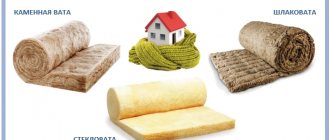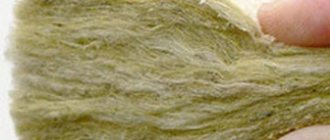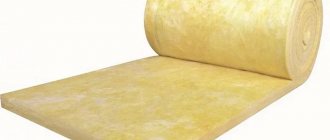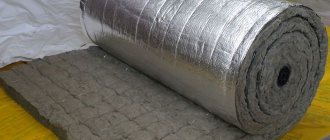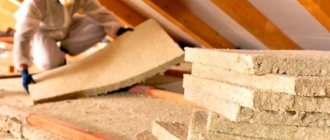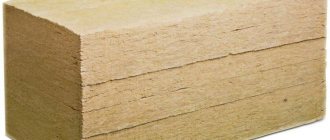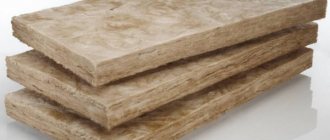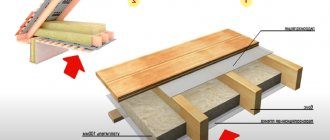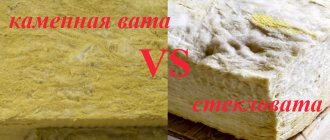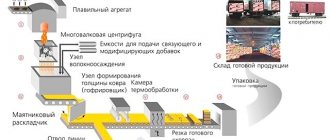Basalt wool is a material that is often used as insulation. In terms of its heat-saving properties, it is the best option among building materials: it forms an air gap, does not dampen, and is durable. But there is a widespread belief that basalt wool is harmful to health. We need to find out if this is really the case.
Basalt - you can’t get more natural
To produce mineral wool, rock is melted and crushed. This material is also called stone wool because it is actually made from stone. The most commonly used rock is basalt-igneous rock, which is environmentally friendly and is even used in medicine. Thus, the base of the insulation is harmless to humans.
Resin is then used to bond the resulting fibers together. The composition of the latter determines whether mineral wool causes harm to the body. The manufacturer decides what type of this substance to use.
Some resins do not contain harmful components, and then the material is practically harmless. But sometimes phenol and formaldehyde are added to the composition - components harmful to health.
Areas of application
The characteristics of basalt wool make it a universal material, used both inside and outside buildings for various purposes. Insulation with basalt wool is suitable for baths and saunas, chimneys and pipelines, and metal structures. The material is used to insulate walls, ceilings, and floors; the correct choice and other problems that can be solved with the help of basalt material are important.
Thermal insulation of the pipe using basalt (stone) wool. Photo of SuperOven
Harm to health of mineral wool microparticles
It is believed that maximum harm to the body is caused by inhaling mineral insulation fibers. It's true: getting microparticles of basalt and resin into your lungs will not bring anything good. When cutting mineral insulation during construction work, fine dust is released, so you should work in a gauze bandage.
But once the insulation is already in place, it does not produce dust on its own. In addition, in most cases, the material is covered with a film to increase thermal insulation properties and waterproofing. This ensures the safety of the mineral wool.
There is mineral insulation of the latest generation, which does not chip and creates almost no dust. The reason lies in the elasticity of the acrylic contained in its composition: the fibers associated with this material do not break off and do not fly apart in the form of microparticles. This is not the only advantage of the material; it has improved soundproofing characteristics also thanks to acrylic, which absorbs sound waves more effectively. Thus, it is possible to completely avoid the appearance of dust when using mineral insulation.
How the components of thermal insulation affect health: what to be prepared for
The greatest harm to health comes from individual particles of material entering the air. Descending into a person’s lungs, they tend to accumulate, sooner or later causing the formation of a cyst, which in turn can lead to the development of harmful microorganisms. Is a cyst dangerous? In fact, more than that, since it can lead to the development of malignant tumors.
There are cases where studies have shown that malignant neoplasms were discovered in the bodies of people who inhaled impurities of basalt insulation for a long time.
Formaldehyde resins
Many people want to know whether mineral wool, which contains formaldehyde resins, is harmful. The amount of resin in any basalt insulation is 2-3 %. This substance contains a very small amount of formaldehyde. Thus, mineral insulation contains a minimum amount of substances that affect health.
If you need to completely eliminate the harm of mineral wool, pay attention to manufacturers who do not use harmful substances in production.
When laying insulation, cover it with film and carefully seal the seams to avoid dust. Such mineral wool is not harmful to health.
Main characteristics
Let us describe the properties of basalt insulation in technical language.
Thermal conductivity
The thermal conductivity coefficient of basalt insulation of various brands varies from 0.034 to 0.048 W/m*C. To date, these indicators are considered the best. Porous thermal insulators made of polymers – foam plastics – have approximately the same thermal conductivity.
Vapor permeability
Stone wool easily passes through water in a gaseous state - its vapor permeability is 0.3 - 0.6 mg/m*h*Pa.
Whether this is an advantage or a disadvantage depends on the specific situation.
If the house is built according to European standards, according to which the walls must be made vapor-tight, then this property of the heat insulator is not necessary.
But in this case, to remove excess humidity, you will have to increase the air exchange rate, which will provoke an increase in heat loss. In domestic construction traditions, it is customary to make walls vapor-permeable, which reduces the intensity of ventilation, and therefore heat loss.
With this technology, the insulation must have greater vapor permeability than the main wall material. Then walls made of brick, gas and foam concrete (vapor permeability - from 0.11 to 0.17 mg/m*h*Pa) can only be insulated with mineral wool.
Fire resistance
All wool of mineral origin are non-flammable materials, but basalt insulation is special in this regard, as it has the highest melting point.
Softening of the material begins at a temperature of 1114 degrees.
Thanks to this property, the material looks very advantageous against the background of foam plastics, which burn very well, and even if they have fire-retardant additives, they still smoke a lot during a fire.
Strength
Today, stone wool is produced not only in the form of low-strength mats, but also in the form of slabs, in which the compressive strength can reach 80 kPa (deformation does not exceed 10%). Such slabs can be used to insulate existing flat roofs from the outside.
Energy savings when heating a room can be significantly reduced if the house is well insulated. How to properly insulate a roof - let’s look at the features of thermal insulation for pitched and flat roofs.
Is it possible to insulate a house from the inside and why walls are often insulated from the outside, you will find out here.
For the technology for making ecowool with your own hands, see the link https://microklimat.pro/uteplenie/doma/ekovata-svoimi-rukami.html. Necessary equipment, costs and methods of laying ecowool.
Density
One cubic meter of stone wool, depending on the brand, can weigh from 30 to 400 kg. The lightest varieties with a density of 30 - 50 kg/cu. m are used for internal insulation, the heaviest ones are used for external insulation. For floor insulation, material with a density of 150 kg/m3 is used. m.
Moisture resistance
The most important disadvantage of all fibrous heat insulators is hygroscopicity: they absorb water well, which leads to a significant loss of thermal resistance.
Basalt wool is an exception. At the production stage, its fibers are treated with oils, as a result of which it becomes hydrophobic.
The water absorption rate for most varieties is in the range of 1% - 5%, and only for some brands it can reach 20%.
We must not forget that moisture can enter the structure of basalt wool in the form of steam and condense there. In this case, the insulation, even despite its moisture resistance, will get wet and stop retaining heat.
To avoid such problems, the insulated structure must be calculated in a special program - a thermal calculator (there are many versions, some online).
If the calculation shows that a large amount of condensation will form inside the wool, it must be covered from the room side with a vapor barrier film.
Noise absorption
Unlike rigid foam plastics (except for polyethylene foam), all mineral wool insulation is soft. Thanks to this, they are good sound insulators. Thus, using basalt insulation, the user solves two problems at once - thermal insulation and sound insulation.
Resistance to active biological environment
The importance of this property of mineral wool in general and basalt wool in particular cannot be overestimated. The material is not afraid of any pests - from bacteria and fungi to rodents. Not all heat insulators can boast of this quality. Foam plastic, for example, is affected by mice, which like to build entire passages in them.
Is it harmful during installation?
The harm of mineral wool during installation work is often mentioned. If you handle this material with bare hands, the tiny sharp fibers can dig into the skin and cause irritation. Therefore, you should only work with it while wearing gloves.
However, if stone wool gets on your hands without gloves, nothing bad will happen. You just need to thoroughly wash your palms with cool water (so as not to enlarge the pores), and then collect all the fibers from the skin by hand. Experienced installers use masking tape to remove these particles, applying it with the adhesive side to those areas of the skin that came into contact with the mineral wool.
When working with basalt insulation, it is recommended to use a gauze bandage or at least a scarf to cover the respiratory organs. This is especially true when you have to cut mineral wool. There is no harm when installing thermal insulation film, so the gauze bandage can be removed.
Mineral insulation with acrylic in its composition does not cause harm. In addition, it has increased elasticity. When installed inside buildings, a “spring effect” occurs and the insulation fills the entire allocated space, leaving no cracks or gaps. No additional protection against dust flying is required.
Citizen Science
The project team also studied how members of the public would react to such technologies. It is clear from studies conducted in the United Kingdom and United States that CO2 removal strategies may face skepticism. Respondents to surveys and workshop discussions feared that their development might take too long and expressed concern that basalt dust could impact ocean ecology. Many also opposed the idea that such technologies would become a substitute for addressing the root causes of climate change.
Found a violation? Report content
Ursa Pure One
Ursa Pureone mineral wool has the best thermal insulation properties. At the same time, it is environmentally friendly and does not contain any harmful substances. The use of phenol and formaldehyde in production is completely excluded. This is the latest generation material, differing from simple mineral wool even in appearance: it is white, reminiscent of cotton or sheep's wool.
Instead of basalt, quartz sand is used, which accounts for the white color of the material. Instead of resin, acrylic is used as a connecting component - a safe polymer substance.
Description
Basalt wool is a type of mineral wool , which is a fibrous material intended for insulation and thermal insulation of chimneys, pipelines, etc.
The history of basalt wool began with the rock after which it was named. Basalt belongs to cenotype stones , that is, those rocks whose appearance does not change with “age.” Basalt is a rock formed from magma that has a dense and granular structure. The minerals used as grains are magnetite and titanomagnetite, climopyroxene, and volcanic glass. The plasticity of basalt allows it to break out to the surface through volcanic vents under the pressure of hot gases. The air cools the magma, which solidifies into filaments . The breed was first seen in this form by residents of the Hawaiian Islands in the 1930s. Later the breed was recreated in the laboratory.
Basalt wool is often used as insulation for steam rooms in frame baths
Industrial basalt wool differs from volcanic wool. However, the structures are similar - a mass consisting of fibers (threads) with air inside. Externally, basalt wool has a beige or gray color. In cotton wool of natural origin, the threads are arranged chaotically, but the production technology of factory materials allows us to note the length of the threads, which is about 50 mm, and the thickness, measured in microns, and diameter.
The production of cotton wool in industrial conditions is carried out by blowing basalt melt , the process is carried out in closed furnaces. Rock fragments from quarries are used as raw materials , which are melted into aggregates. Threads are blown from the molten mass and wound onto a rotating drum. Fibers that have not completely hardened are cut, fastened with polymers (bitumen resins are most often used) and put under a hot press. As a result, the finished product takes the form of mats or slabs . Although there are other forms. In any case, cotton wool has the following characteristics.
Basalt powder as plant protection against diseases
As with pest control, basalt powder helps limit the development of plant diseases. Plants are treated with basalt powder against fungal diseases in the same way as against pests.
Silicon compounds contained in flour increase plant immunity, helping to fight diseases such as potato scab, gray mold, powdery mildew and many other diseases of fungal origin.
Basalt flour can also be used to treat seeds, bulbs and roots of transplanted biennial and perennial plants (for example, when separating and replanting new seedlings). The seeds are coated with basalt flour several days before sowing.
Manufacturers
Differences are present in materials not only of different types, but also those produced by different enterprises. Leading companies offer a wide selection of basalt materials, which have some differences in basic characteristics, primarily thermal conductivity and density. Well-known manufacturers are Rockwool, Technonikol, Knauf, Isover, as well as other enterprises, the range and features of whose products are discussed in a separate article.
Types of facades that are especially dangerous
Speaking about the dangers of stone wool, we should mention ventilated facades, thanks to the use of which it is possible to minimize heat loss in the winter and at the same time maintain coolness in the summer months.
The technology of their construction requires creating a gap between the walls and the stone wool, which will ensure not only ventilation, but also the removal of excess moisture. This solution explains why, over time, this insulator becomes a source of the formation of tiny dust particles, which subsequently spread through windows, doors, and ventilation. If you stay in such a room for a long time, there is a risk of developing lung diseases and even cancer. In addition, stone wool particles can cause irritation to the eyes, mucous membranes and even skin.
The negative impact of stone wool is associated with microparticles that look like needles, which penetrate into the lungs during breathing. But during exhalation they no longer come back out. Over time, they accumulate in the body, which creates favorable conditions for the development of quite dangerous diseases.
